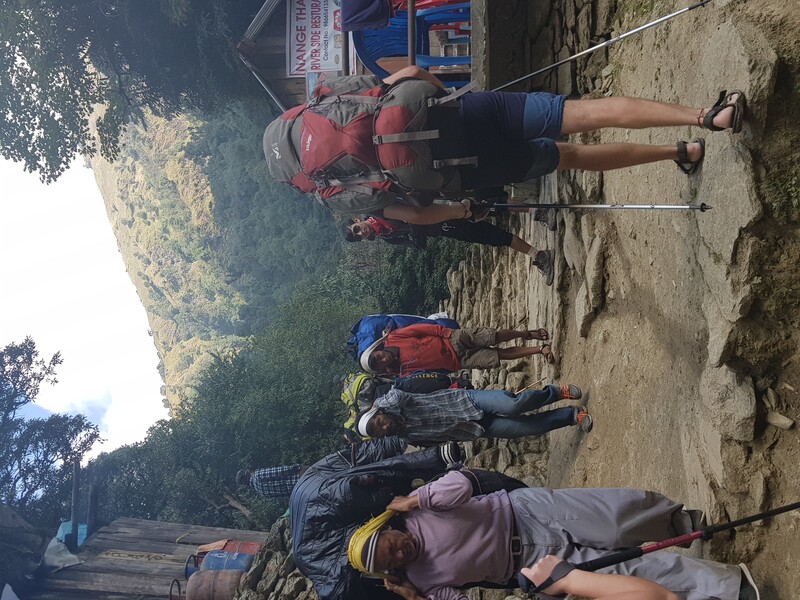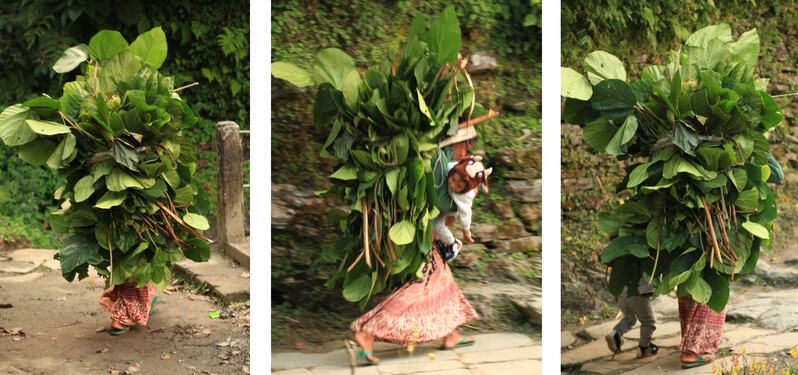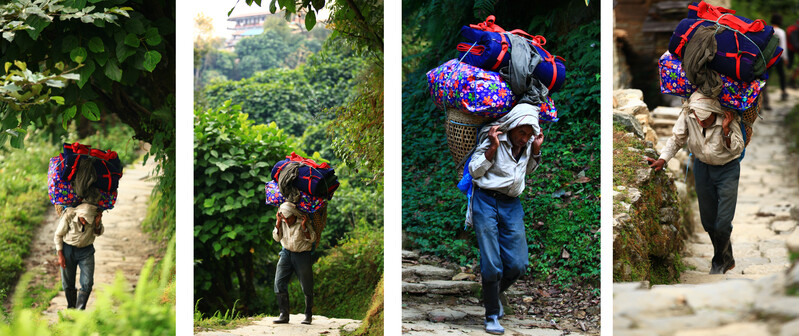*Editor's note: K-VIBE introduces travel journals by alumni of Yonhap News Agency Travel Academy, provided in Korean and English. The original Korean article precedes the English translation.
*편집자 주: K-VIBE는 연합뉴스 <여행자학교> 수료생들의 여행기를 한국어와 영어로 소개합니다. 한국어 원문을 먼저 게재한 뒤 외국 독자들을 위해 영어 번역본도 함께 싣습니다.
무거운 짐을 축복으로 보게 되던 날
신훈 (여행자학교 5기)
히말라야 트레킹에서는 대부분 트레커, 가이드, 포터가 한 팀을 이룬다. 대규모 팀에는 요리사까지 동반하는 경우도 있다. 가이드는 필수다. 꼭 안전 때문만은 아니다.
종종 가이드 없이 나선 트레커들의 사망 소식이 전해지기도 하지만, 히말라야라는 오지에 빠르게 적응하고 즐기기 위해서 가이드는 매니저처럼 모든 일정을 책임진다.
포터는 짐으로부터 트레커를 해방시킨다. 위험성에도 불구하고 두 조력으로 인해 히말라야 트레킹이 관광 상품이 된다.
의도적으로 줄였다기보다 부실한 준비로 나의 짐은 비교적 단출했다. 사진기와 200mm 줌을 포함한 세 개의 렌즈가 가장 큰 짐이었다. 1주일 산행 동안 여러 등산객이 챙겨온 짐들을 살펴보았다.
트레커들의 짐은 분량이나 내용이 많은 차이가 있었다. 같은 산에 온 것인가라는 의문이 들 정도로 반바지부터 파커까지 복장은 물론이고, 거대한 개인 배낭부터 포터를 사용하는 경우까지 천차만별이었다.
 |
생필품이 귀한 고산 지대이니, 등산객 뿐 아니라 현지인들이나 당나귀 조랑말 등 모든 이동하는 것들은 다양한 짐들을 나른다. 산다는 건 매일 짐을 지고 산을 오르는 것이다. 비유가 아니다. 히말라야의 매일이다.
 |
이색적인 짐도 있었다. 딱히 용도를 추측하기 힘든 거대한 나뭇짐을 지고 이동하던 여인은 걸음걸이가 매우 빨랐다. 나중에 보니 놀랍게도 가슴에 어린 아이를 안고 있었다. 여인은 전혀 힘들어 하지 않았다.
 |
그러다 히말라야에서 가장 인상적인 짐을 만났다. 산을 오르다 잠시 쉬던 중이었다.
 |
짐이 걸어오고 있었다. 내 배낭보다 스무 배는 될 것 같은 크기. 큰 짐이 짐 진 이를 산 위로 떠미는 듯도 했고, 잘못하면 짐 지고 오는 이가 금시라도 짐에 깔릴 것 같은 형편이었다.
바라보는 동안 눈은 위쪽 꽃무늬 짐으로 옮겨갔다. 가파른 히말라야 오르막에서 꽃무늬 짐은 묘한 페이소스랄까, 낯선 아름다움을 자아내고 있었다. 그러나 짐 무게가 덜 하지는 않으리라.
나의 짐도 멀리서 보면 아름다울까.
갑자기 그런 생각이 들었다. 누군가가 무거운 짐을 지고 가는 내 모습을 아름답다고 생각했다면……. 거기에 생각이 미치니 그에게 미안했다.
우리 포터인 아르 준이 지고 가던 짐이 생각 난 것은 그 때였다. 아르 준은 두 개의 짐, 하나는 지고 하나는 가슴에 안고 걸었다.
사실 다른 등반 팀에 비해서 우리 짐은 매우 적었으나, 아르 준은 체구가 작은 편이었다. 꽃무늬 짐을 진 이에게 미안했던 마음이 아르 준의 짐을 덜어주고 싶은 생각을 들게 했다.
“아르 준, 무겁지 않아? 내 짐이 가벼우니 조금 덜어도 괜찮아.”
아르 준은 내 제안에 손사래를 치며 거절했다. 약간 상기된 얼굴과 과장된 웃음은 그가 매우 당황했음을 보여주고 있었다. 의아했지만 더 이상 묻지 않았다.
15세 사무엘이 가르쳐 준 ‘짐’의 의미
얼마 후 가이드 사무엘이 내게 조용히 말을 건넸다. 그 말은 대략 다음과 같다.
“당신 짐을 맡기는 것을 미안해하지 마라. 그는 당신 짐을 지고 돈을 번다. 그 돈으로 가족을 먹여 살린다. 그에게 짐은 기회다.”
“신 선생님,(사무엘은‘선생님’이라는 호칭이 나 같은 고객에게 가장 잘 어울리는 호칭이라고 선택한 듯했다. 이 호칭은 그의 묘한 악센트와 함께 22 살짜리 어린 가이드를 당당한 전문가로 대하게 하는 효과가 있었다. 나는 그가 나를 이렇게 부를 때마다 미소가 나왔다). 저는 15세부터 짐을 졌어요. 제가 어릴 때는 관광객의 짐은 상대도 안 되는 100 키로가 되는 짐도 졌어요. 그러나 저는 제 미래를 지고 있는 거라고 생각했어요.”
스물한 살 네팔 청년이 한국어로 말한 ‘미래를 지고 있는’이라는 표현은 놀라웠다. 무거운 짐을 나르면서도 영어를 공부하고, 한국어를 공부했던 사무엘이었다. 나중에 가이드가 되겠다는 꿈 때문이었다. 사무엘은 꿈을 이루었다.
짐이 기회다
누군가의 짐이 누군가에게는 기회가 된다. 그 한마디가 길을 걷는 내내 머리에 맴돌았다. 짐이라는 단어는 매우 평범하다. 히말라야 특성상 짐에 대해서 나보다 훨씬 많은 고민을 한 사무엘이었을 것이다.
삶은 생각만큼 좁아지기도 하고 깊어지기도 한다. 짐에 대한 그의 생각은 냉철하고 깊다.
나도 평생 내 짐을 지고 왔다. 버거운 짐을 진 적도 있었을 것이다. 짐을 진 순간은 힘들지만, 짐이 갖는 의미마저 힘든 것은 아닐 수 있다. 짐은 우리가 현실을 벗어날 수 있는 기회일 수 있다.
| ▲ 포터였던 아르 준. 나이가 19세 정도였던 것 같다. |
그렇게 생각하고 나니, 작은 체구의 아르 준이 당당해 보였다. 내 맘도 편했다. 그의 미래를 기원했다.
잠시 사라졌던 짐꾼이 다시 우리 앞에 나타났다. 어디서 쉬었던 것일까. 뒤에서 보는 짐은 이전보다 더 커 보였다. 똑 같은 보폭. 조금도 빨라지거나 더뎌지지 않은 속도로 그는 산을 올랐다.
한참을 바라보다 조심스레 한 장 더 사진을 찍는다. 찍은 사진을 보며 어쩜 그가 걷는 길 끝에는 따뜻한 저녁을 함께할 가족이 기다리고 있을 것 같은 생각을 했다.
그날 밤 꿈속에서 나는 15세 사무엘을 만났다. 어린 사무엘이 나에게 무슨 이야기를 했는지 전혀 생각이 나질 않는다. 딱 하나 기억나는 것은, 어리지만 빛나는 사무엘의 눈이었다.
어린 사무엘을 보고 잠을 깬 후 좀처럼 다시 잠에 들 수 없었다. 네팔의 밤은 나에게 잠들 수 없는 많은 얘기를 자꾸 풀어내주고 있었다.
| ▲ 가이드 사무엘. 22살 치곤 성숙한 모습. 아름다운 눈. |
The day I learned to see my burden as blessing
By Shin Hoon (Alumnus of Travel Academy season 5)
A typical Himalayan trekking team consists of trekkers, a guide and a porter. In some cases, larger teams even include cooks.
Every team needs its guide, not just for safety. We occasionally hear news about the deaths of unguided trekkers. But even without such knowledge, there must be a guide to take on the responsibility of managing everything in order to help the team quickly adapt and enjoy the remote Himalayas.
Porters liberate trekkers from their baggage. Despite safety concerns, porters and guides together make the Himalayan trekking a tourism commodity.
My luggage was relatively modest, not intentionally but due to sloppy preparation. The most substantial items were my camera, a 200-millimeter zoom lens and two other lenses.
During the weeklong trek, I observed various kinds of luggage brought by fellow hikers. Their outfits ran the vast gamut from shorts to parkas. Some brought humongous personal backpacks in aid of porters.
 |
In the scarce high-altitude regions, both hikers and locals, including mules and horses, carry various loads. Here, life means “climbing the mountains every day, loaded.” It’s not a metaphor; it's the daily routine of the Himalayas.
 |
There were even exotic loads. A woman walked swiftly, carrying an enormous bulk of wood, the purpose of which was hard to guess. Later, I was astonished to find she was also carrying a young child on her chest. She seemed entirely unfazed by the weight.
 |
Then, in the Himalayas, I encountered the most impressive load. That’s when I was taking a short break to catch my breath.
 |
A gigantic load was approaching us, probably at least 20 times larger than my own backpack. The bearer seemed almost overwhelmed by the sheer size of the load, and there was a risk that, if mishandled, the carrier might be buried under it.
While observing, my eyes shifted to the load, covered in flowery patterns. In the steep ascent of the Himalayas, the flowery load exuded a strange sense of a peacock, radiating unfamiliar beauty. However, the weight of the load was no less burdensome.
Perhaps from a distance, my load might also look as beautiful.
Such thought suddenly crossed my mind. But imagining someone beautifying my heavy load... alas. I felt remorse at my tactless thought.
The scene reminded me of Arjun, my porter. It was when I thought about his load, carrying one on his back and another on his chest.
In fact, compared to other climbing teams, our load was minimal, but Arjun was rather tiny. I felt an urge to vent my remorse about the flowery load guy by taking away some of Arjun’s burden.
I asked him, "Arjun, isn't it heavy? My load is light; I can take some off from yours."
Arjun turned down my offer, slightly embarrassed. His puzzled face and exaggerated laughter indicated his surprise. Although I was curious, I didn't press further.
"15-year-old Samuel taught me the meaning of 'load.'"
A while later, my guide Samuel quietly spoke to me. His words were roughly as follows: "Don't feel sorry for handing over your load. He earns a living by carrying your load. He feeds his family with that money. For him, the load is an opportunity."
"Shin seonsaengnim," (Samuel seemed to have chosen the title “seonsaengnim,” meaning teacher, as the most fitting for customers like me, given his peculiar accent. This title, along with his strange accent, made the 22-year-old guide appear confidently professional. I smiled every time he called me that).
"I've been carrying loads since I was 15. When I was young, I carried loads weighing up to 100 kilograms, which is nothing compared to tourists' loads. But I thought I was carrying my future."
The 20-year-old Nepalese young man spoke in Korean, saying he was “carrying his future.” It was astonishing. Samuel studied English and Korean while carrying heavy loads. It was all for his dream of becoming a guide. Samuel realized his dream.
"A
load can be an opportunity."
Someone's burden can become someone else’s opportunity.
That single phrase echoed in my head as I walked. The word “load” is very ordinary. Considering the nature of the Himalayas, Samuel must have thought much more about loads than I did.
Life can narrow or deepen as much as thoughts do. His thoughts on loads were pragmatic and profound.
I, too, have carried my own load throughout my life. There have been times when the burden was heavy, but the meaning of the load may not be so difficult.
| ▲ Arjun, the porter. He seemed about 19 years old. |
Thinking that way, Arjun seemed confident despite his small stature. I felt relieved. I wished him a bright future.
The load carrier who had disappeared for a while reappeared before us. I wondered where he had rested. From behind, the load seemed even larger than before. His stride was just the same. He ascended the mountain at the same steady pace, neither faster nor slower.
After watching for a while, I cautiously took another photo. Looking at the photo, I thought, at the end of his journey, his family would warmly receive him for a shared evening.
That night, in my dreams, I met 15-year-old Samuel. I couldn't remember what the lad had said. The only thing I remembered was his young, shining eyes.
After seeing the boy and waking up, I couldn't fall asleep again. The Nepalese night kept telling me many stories that kept me awake.
| ▲ Guide Samuel. Mature for a 22-year-old. Beautiful eyes. |
(C) Yonhap News Agency. All Rights Reserved

























![[가요소식] 보이넥스트도어, 신보로 3연속 밀리언셀러 달성](/news/data/20251025/yna1065624915905018_166_h2.jpg)








